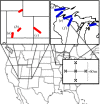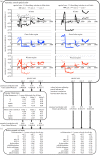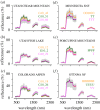Imaging spectroscopy links aspen genotype with below-ground processes at landscape scales
- PMID: 24733949
- PMCID: PMC3983929
- DOI: 10.1098/rstb.2013.0194
Imaging spectroscopy links aspen genotype with below-ground processes at landscape scales
Abstract
Fine-scale biodiversity is increasingly recognized as important to ecosystem-level processes. Remote sensing technologies have great potential to estimate both biodiversity and ecosystem function over large spatial scales. Here, we demonstrate the capacity of imaging spectroscopy to discriminate among genotypes of Populus tremuloides (trembling aspen), one of the most genetically diverse and widespread forest species in North America. We combine imaging spectroscopy (AVIRIS) data with genetic, phytochemical, microbial and biogeochemical data to determine how intraspecific plant genetic variation influences below-ground processes at landscape scales. We demonstrate that both canopy chemistry and below-ground processes vary over large spatial scales (continental) according to aspen genotype. Imaging spectrometer data distinguish aspen genotypes through variation in canopy spectral signature. In addition, foliar spectral variation correlates well with variation in canopy chemistry, especially condensed tannins. Variation in aspen canopy chemistry, in turn, is correlated with variation in below-ground processes. Variation in spectra also correlates well with variation in soil traits. These findings indicate that forest tree species can create spatial mosaics of ecosystem functioning across large spatial scales and that these patterns can be quantified via remote sensing techniques. Moreover, they demonstrate the utility of using optical properties as proxies for fine-scale measurements of biodiversity over large spatial scales.
Keywords: above- and below-ground linkages; intraspecific diversity; plant chemistry.
Figures



References
-
- Vitousek PM, Mooney HA, Lubchenco J, Melillo JM. 1997. Human domination of earth's ecosystems. Science 277, 494–499. (10.1126/science.277.5325.494) - DOI
-
- Haberl H, Erb KH, Krausmann F, Gaube V, Bondeau A, Plutzar C, Gingrich S, Lucht W, Fischer-Kowalski M. 2007. Quantifying and mapping the human appropriation of net primary production in earth's terrestrial ecosystems. Proc. Natl Acad. Sci. USA 104, 12 942–12 945. (10.1073/pnas.0704243104) - DOI - PMC - PubMed
Publication types
MeSH terms
Substances
LinkOut - more resources
Full Text Sources
Other Literature Sources
Molecular Biology Databases

